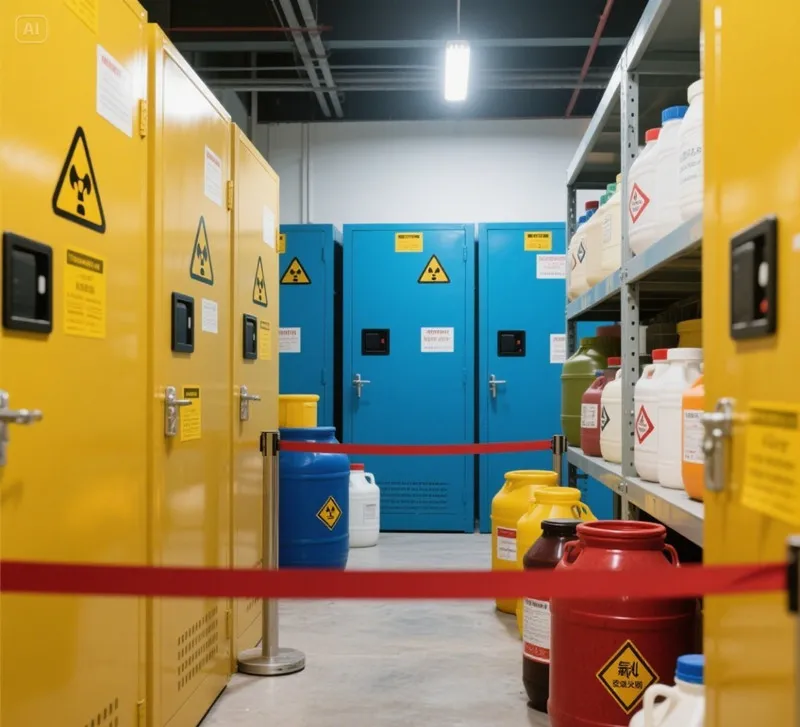Chemicaliën zijn essentieel voor tal van industrieën, van productie en onderzoek tot gezondheidszorg en landbouw. Veel chemicaliën vormen echter significante risico's als ze niet correct worden behandeld en opgeslagen. Veilige chemische opslag is niet alleen een wettelijke noodzaak; Het is een fundamenteel aspect van het beschermen van uw werknemers, uw faciliteit en het milieu.

Why is Safe Chemical Storage So Critical?
● Protecting Lives:Improper chemical storage can lead to spills, leaks, fires, and explosions, causing serious injuries or fatalities. Prioritering van veiligheid beschermt uw werknemers en iedereen die met uw faciliteit communiceert.
● Environmental Responsibility:Chemische releases kunnen bodem, waterbronnen en lucht verontreinigen, wat resulteert in dure milieuschade en potentiële juridische gevolgen. Verantwoordelijke opslag minimaliseert uw milieu -impact.
● Regulatory Compliance: Local, national, and international regulations govern the storage and handling of hazardous chemicals. Failing to comply can result in hefty fines, operational shutdowns, and reputational damage.
● Bedrijfscontinuïteit: Accidents caused by improper storage can disrupt operations, damage equipment, and lead to prolonged downtime. Safe practices ensure the resilience of your business.
Key Principles of Safe Chemical Storage:
Implementing a robust chemical storage program involves a comprehensive approach. Here are some essential elements:
Segregation and Compatibility: Never store incompatible chemicals together. Consult a chemical compatibility chart to determine which substances react dangerously when mixed. Store acids separately from bases, oxidizers separately from flammables, etc.
Proper Container Selection:Use containers specifically designed for the chemical being stored. Zorg ervoor dat containers zijn gemaakt van materialen die compatibel zijn met de chemische stof en resistent tegen corrosie. Consider factors like pressure, temperature, and potential for degradation.
Clear Labeling:Alle containers moeten duidelijk en nauwkeurig worden gelabeld met de chemische naam, Hazard -waarschuwingen en alle noodzakelijke voorzorgsinformatie. Volg het wereldwijd geharmoniseerde systeem (GHS) normen voor gevarenpictogrammen en signaalwoorden.
Ventilatie: Provide adequate ventilation in chemical storage areas to prevent the buildup of hazardous vapors. Consider installing local exhaust ventilation systems for particularly volatile chemicals.
Temperature Control: Many chemicals require specific temperature ranges for safe storage. Monitor and control the temperature of storage areas to prevent degradation, polymerization, or other undesirable reactions.
Spill Containment: Implement spill containment measures, such as spill pallets, berms, or diking, to prevent chemicals from spreading in the event of a leak or spill. Keep spill response equipment readily available.
Fire Protection:Chemische opslaggebieden moeten worden uitgerust met geschikte brandonderdrukkingssystemen, zoals brandblussers, sprinklersystemen of schuimonderdrukkingssystemen. Zorg ervoor dat brandalarmsystemen functioneel zijn en regelmatig worden getest.
Beveiliging: Control access to chemical storage areas to prevent unauthorized entry and potential tampering. Implement security measures such as locks, fences, and surveillance cameras.
Training:Bied een uitgebreide training aan alle werknemers die in de buurt van chemicaliën omgaan of werken. Training moet betrekking hebben op chemische gevaren, veilige hanteringsprocedures, noodhulpprotocollen en het juiste gebruik van persoonlijke beschermingsapparatuur (PBM).
Regelmatige inspecties:Voer regelmatige inspecties van chemische opslaggebieden uit om mogelijke gevaren te identificeren en te corrigeren. Inspecteer containers op lekken of schade, controleer ventilatiesystemen en zorg ervoor dat de beheersingsmaatregelen van de lekkage aanwezig zijn. Houd een logboek bij van deze inspecties.
Beyond the Basics: Additional Considerations
● Hazard Risk Assessments: Conduct thorough hazard risk assessments to identify potential risks associated with chemical storage and develop appropriate control measures.
● Safety Data Sheets (SDS): Ensure that SDSs are readily available for all chemicals stored on-site. SDSs provide critical information about chemical hazards, handling procedures, and emergency response.
● Waste Disposal: Implement a system for the safe disposal of chemical waste, following all applicable regulations.
● Working with a Specialist:Overweeg samen te werken met een bedrijf dat gespecialiseerd is in chemische veiligheid om audits uit te voeren, training te geven en deskundig advies te geven.
Conclusie:
Safe chemical storage is an ongoing commitment that requires vigilance, planning, and training. Door de principes in dit artikel te implementeren, kunt u de risico's die verband houden met gevaarlijke chemicaliën aanzienlijk verminderen en een veiliger, gezondere en meer conforme werkplek creëren. Prioritizing chemical safety is not just good for your business; it's the right thing to do.
